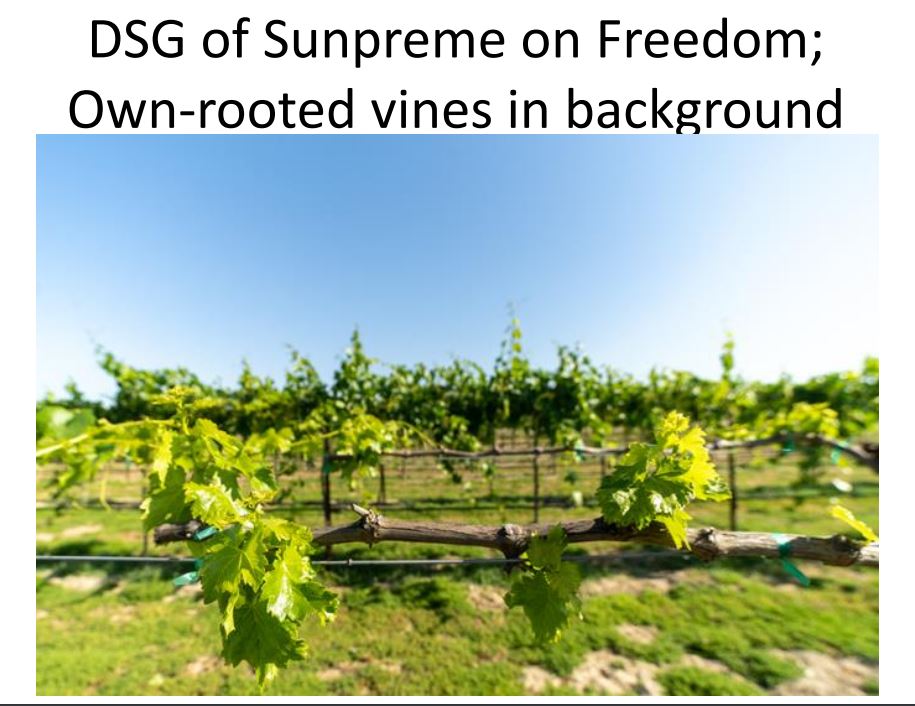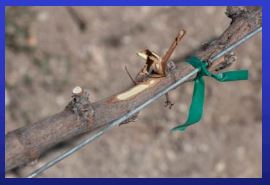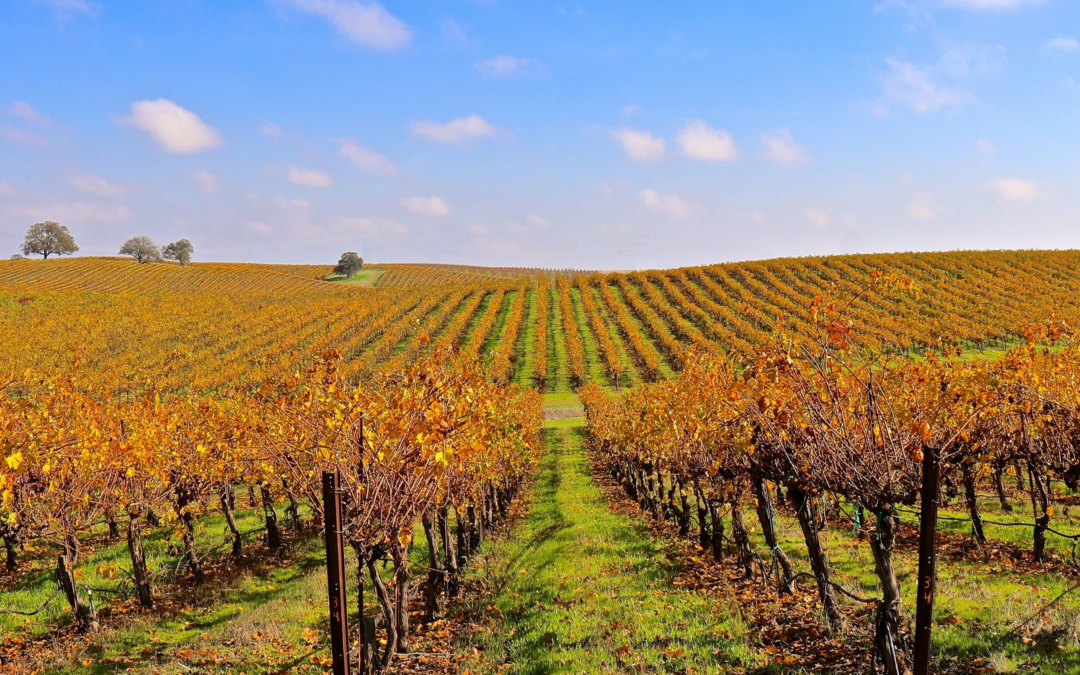MONDAY, NOVEMBER 22, 2021. BY TED RIEGER.
Post-harvest vineyard management practices are important to prepare grapevines to shut down for winter dormancy and to withstand cold temperatures while also storing reserves in woody tissues to begin spring growth for the following growing season.
The Lodi Winegrape Commission (LWC) and E & J Gallo Winery co-hosted a workshop for growers October 28th focused on post-harvest practices to prevent and mitigate delayed spring growth (DSG), an issue in Lodi vineyards in 2021 and in other California grape growing regions related to drought and cold damage. (For more information, see Lodi Wine Growers Coffee Shop Blog entry posted May 12, 2021: “Lodi Growers Report Vine Growth Problems From Fall 2020 Cold Damage.”)
DSG Symptoms, Factors, Prevention
University of California Cooperative Extension (UCCE) Viticulture Specialist Dr. Matthew Fidelibus, based at the UC Kearney Agricultural Research and Extension Center in Parlier, Fresno County said DSG is more commonly observed on young vines. It is characterized by poor budbreak and delayed shoot elongation, and it is especially common on canes, and particularly in the middle of canes. He listed several factors that can increase the likelihood of DSG: young vines, cane pruning, overcropping, certain varieties and rootstocks can be more susceptible, late harvest, excessive late season growth, warm fall temperatures, and dry soil in fall and winter.
Fidelibus said, “Dry soil in fall and winter has been a problem the past few years (related to drought) and with warm fall temperatures, the vines kept growing and weren’t acclimating for the winter. In 2020, we had a really warm October followed by a cold snap in early November.” In the Lodi AVA from November 8, 2020 through November 12, 2020 minimum daily temperatures of 32 degrees F and lower were recorded at several weather stations in the Lodi Weather Network over five consecutive days that resulted in vine cold damage and DSG.
Fidelibus also observed that based on seasonal weather trends, the rainy season is tending to start later in the San Joaquin Valley than it has historically–nearly a month later and closer to winter rather than in the fall. This suggests the need to apply post-harvest irrigation in the fall in dry years to maintain soil moisture, if irrigation water is available. Irrigation may also be needed in saline soils to leach salts below the root zone.
Fidelibus emphasized the need to properly balance post-harvest irrigation applications in dry years. The goal is to maintain the vine canopy to accumulate carbohydrates and nutrients in vine woody tissues as reserves for spring growth, but not allow the vine to continue growing too late to prevent shut-down and dormancy before cold temperatures arrive. “Irrigation amounts need to be just right, you don’t want to over-irrigate or under-irrigate,” Fidelibus advised. Soil moisture sensors can be good tools for monitoring soil moisture levels and managing the vineyard’s post-harvest water budget.
Based on dry conditions this year–early fall 2021–many Lodi growers initially applied post-harvest irrigation to maintain vineyard soil moisture. However, record rainfall around October 23-25 in the Lodi area likely provided sufficient soil moisture levels to reduce or eliminate the need for additional fall irrigation in most vineyards.

Excerpt slide from Dr. Matt Fidelibus’ presentation on Delayed Spring Growth (DSG), showing symptoms of DSG in the foreground vines on Freedom rootstock in contrast with healthy own-rooted vines in the background.
Regarding seasonal grapevine physiology and nutritional requirements, Fidelibus explained that dormant buds are dehydrated and have relatively weak vascular connections with the vine. In spring, sap flow helps resolve embolisms and rehydrate buds. The rehydrated buds must develop new vascular connections with the vine to support growth. “Irregular budbreak and stunted shoots suggest insufficient reserves or vascularization,” Fidelibus said. Carbohydrates, water and minerals are needed to resolve embolisms and rehydrate and feed developing shoots as they emerge from dormancy.
Vine nitrogen (N) demand is high in spring and summer, and N applications should be timed to meet these seasonal needs. Although some growers apply a percentage of their nutrient budget post-harvest through fertigation when water is available, Fidelibus suggests that post-harvest N applications may be less efficient and may not always be necessary. He noted that N content in the trunk and roots increases at the end of the season with reallocation in the vine from senescing leaves that no longer need N. Additional N can also come from organic matter in the soil.
To prevent DSG, Fidelibus recommends: maintain vine pruning level and crop load consistent with vine capacity; provide effective disease management, particularly for powdery mildew; and provide irrigation and nutrition management that maintains the canopy without preventing late season growth. Dry soils in fall and winter can predispose vines to DSG, and it is important to avoid severe vine stress that constrains carbohydrate accumulation. In general, he summarized, “Maintain the vines in good condition to prevent DSG.”
Click HERE for a link to Dr. Matt Fidelibus’ presentation.
UCCE Viticulture Farm Advisor Larry Bettiga talked about his experience with DSG in the Central Coast Counties of Monterey, San Benito and Santa Cruz. Bettiga observed, “A multitude of things can cause spring shoot stunting, and often times these things can be interacting together.” He listed the following factors: winter cold injury, drought injury, overcropping/early cropping of young vines, anaerobic/restrictive soils, lack of chilling hours, low carbohydrate reserves, pest/pathogen induced issues, and physiological disorders. He observed, “Last year we saw the perfect storm of a post-harvest sequence of high temperatures, dry soils and an early cold chill.”

Excerpt slide from Larry Bettiga’s presentation, showing how to investigate plant tissue for dryness.
Winter cold injury can affect and damage vine tissues including buds, phloem tissue, xylem tissue and vascular cambium. Bettiga said, “The extent of the damage has an effect on the rate of recovery and the productivity of the vines.” Damage is often correlated with low spots in the vineyard where colder air tends to pool and temperatures are lowest. To assess vine damage at the beginning of the growing season, Bettiga said when cutting into the vine wood there should be some moisture if the vine is still functional. If the wood is dry and brown, it is damaged and should be cut back. Depending on the damage, the vine may have to be retrained from a sucker. If the vine has severe trunk damage, it can be cut back below the damage and regrafted.
For managing newly planted and younger vines, Bettiga recommends:
- Plant new vines early in the year to allow establishment and growth during the normal growing season rather than exposing them to stress too soon after planting.
- Avoid strong late season growth. Younger vines tend to remain active later into the fall and can be more susceptible to cold damage because they haven’t reached dormancy.
- Consider scion/rootstock selection appropriate for sites with a history of cold temperatures.
- Avoid overcropping young vines in early years.
- If DSG occurs, cut back damaged tissue and crop the vine according to its capacity.
For managing mature vineyards to prevent DSG, he said avoid overcropping, maintain canopy health into post-harvest, and do post-harvest irrigation if necessary to maintain soil moisture. If DSG occurs, crop the vine based on canopy development.
Bettiga also advised implementing soil management practices that promote rain and water infiltration, particularly during drought conditions. Winter cover crops enhance soil penetration of winter rains. Some growers have added berms at the ends of rows to help hold water for inflitration during seasons when rainfall is less certain.
Accumulated vine stress can occur over time from pushing large crops. “You can produce large crops and kill vines,” Bettiga warned.
Click HERE for a link to Larry Bettiga’s presentation.
Susceptible Rootstocks and Varieties
Observed and anecdotal information suggest that certain rootstocks and winegrape varieties may be more susceptible to DSG and winter cold injury. Rootstocks with observed symptoms include Freedom, Harmony, 1103P, 3309, 420A, and 110R.
Varieties observed with symptoms include Chardonnay, Cabernet Sauvignon, Grenache, Merlot, Pinot Gris, Pinot Noir, Sauvignon blanc, and Thompson Seedless. In 2021, cold damage related DSG was also reported in Albariño, Tannat and Zinfandel. Sierra Foothill growers reported DSG in dry-farmed vines. Based on experience, Bettiga says Chardonnay and Pinot Noir seem to be the most susceptible varieties in Central Coast vineyards. Chardonnay is more commonly affected on rootstocks such as 3309, 420A, 110R and Freedom.
DSG Remediation Research–Lodi Field Trial
E & J Gallo Winery Grower Outreach Specialist Dr. Keith Striegler discussed a research field trial conducted in a Pinot noir vineyard block in Acampo that displayed DSG in 2021. Rows side by side were given four different treatments for the 2021 growing season: untreated control, shoot thinning + additional fertilizer, shoot thinning + cluster thinning, and shoot thinning + additional fertilizer + cluster thinning.
Additional data to be collected for 2021 are pruning weights and cane length. Final results of the trial will not be evaluated until fruitfulness and growth are evaluated in 2022. Initial results show that cluster thinning had more impact on improving shoot length and improving yield. However, initial results based on data collection after harvest indicate there does not appear to be a benefit from shoot thinning, cluster thinning, or additional fertilization (beyond normal grower practices) in remediation of DSG in this study, given the additional costs to perform these practices.
Weather Monitoring
Western Weather Group (WWG) provides daily weather monitoring and forecasting services for the LWC throughout the Lodi AVA, with data available to view through the LWC grower website, or by signing up for free daily e-mail forecasts. The LWC Weather Network now includes 37 industrial-grade weather stations.
WWG Meteorologist Brad Wilmot said site-specific fall frost forecasts were added this year to warn growers of potential vine cold damage prior to vine shut down. WWG expects these forecasts will improve over time with more data points and longer record periods. “We can get a better idea of where notoriously cold spots are and validate more specific microclimates, which may also indicate where we may want to add more weather stations,” Wilmot said. Frost alerts for growers from weather stations can be set up through the WWG.
WWG also provides extended 30-day and 90-day weather outlooks with long-range temperature and precipitation forecasts and trends. Other forecasting models and data services include growing season weekly ETo forecasts, powdery mildew stress forecasts, and high temperature/heat stress forecasts for fieldworker safety/OSHA compliance.
Commenting on the record October 2021 rainstorm over the Northeast Pacific, called a “bomb cyclone” due to rapid intensification, Wilmot said this created an atmospheric river over central California that produced 4 to 6 inches of rain at most Lodi weather stations on October 24th alone. “This was almost three-fourths of what we got in total rainfall for all of last year’s rainfall season,” he said.
Click HERE for a link to Brad Wilmot’s presentation.
Ted Rieger is a freelance wine journalist based in Sacramento, California. Since 1988, he has written hundreds of articles for wine industry media and publications reporting on industry news, and about viticultural and enological management, practices, technology and research.
Featured image of Borden Ranch Lodi AVA by Randy Caparoso.
Have something interesting to say? Consider writing a guest blog article!
To subscribe to the Coffee Shop Blog, send an email to stephanie@lodiwine.com with the subject “blog subscribe.”
To join the Lodi Growers email list, send an email to stephanie@lodiwine.com with the subject “grower email subscribe.”
To receive Lodi Grower news and event promotions by mail, send your contact information to stephanie@lodiwine.com or call 209.367.4727.
For more information on the wines of Lodi, visit the Lodi Winegrape Commission’s consumer website, lodiwine.com.
For more information on the LODI RULES Sustainable Winegrowing Program, visit lodigrowers.com/standards or lodirules.org.


